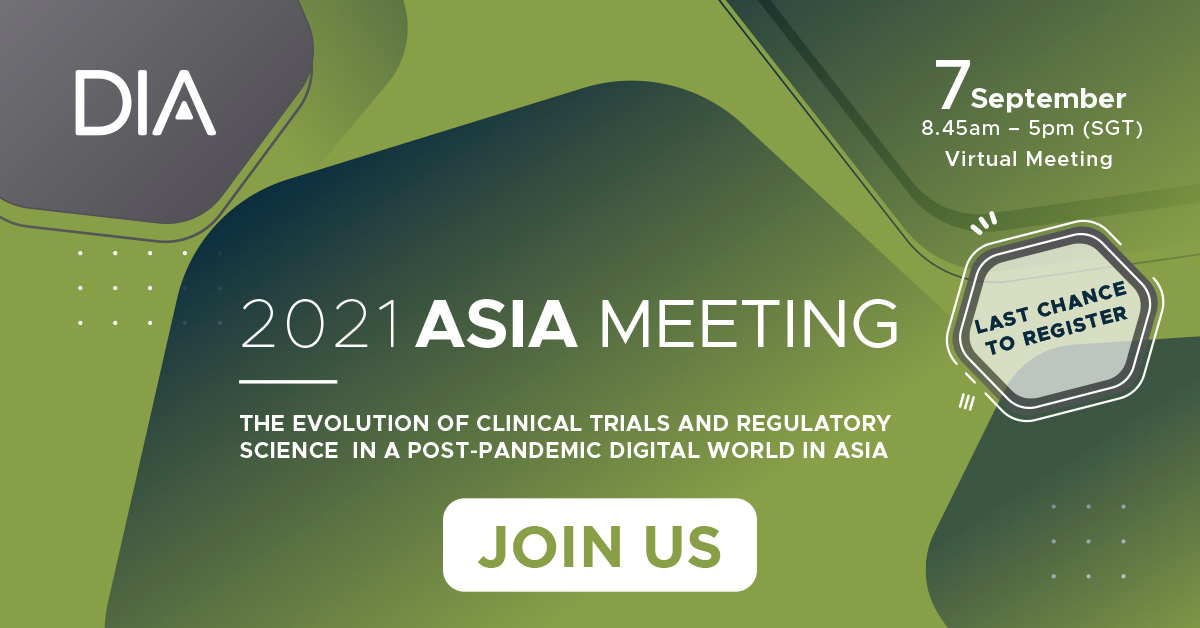Table of Contents
EXECUTIVE LEADERSHIP
Subscribe
Love Global Forum‘s new online format? Subscribe today and never miss an issue.
Editorial Board
Content stream editors
Gary Kelloff US National Institutes of Health
David Parkinson ESSA Pharma, Inc.
regulatory science
Isaac Rodriguez-Chavez ICON plc
Patient engagement
Trishna Bharadia Patient Advocate and Media Contributor
Mary Stober Murray National Minority Quality Forum
VALUE AND ACCESS
Monika Schneider Shionogi
Editorial Staff
Sandra Blumenrath, Managing Editor, Scientific Publications DIA Scientific Communications
Chris M. Slawecki, Senior Digital Copyeditor DIA Scientific Communications
Regional Editors
David Mukanga Bill and Melinda Gates Foundation
ASEAN
Jin Shun Sandoz
AUSTRALIA/NEW ZEALAND
Richard Day University of New South Wales, Medicine, St. Vincent’s Hospital
CANADA
Judith Glennie JL Glennie Consulting, Inc.
CHINA
Ling Su Shenyang Pharmaceutical University, Lilly Asia Ventures
Europe
Thomas Kühler Sanofi R&D
INDIA
J. Vijay Venkatraman Oviya MedSafe
JAPAN
Ozawa Goshi Real World Data Co. Ltd.
LATIN AMERICA
Cammilla Gomes Roche
USA
Ebony Dashiell-Aje BioMarin
Young Professionals Editors
Saloni Patel Acorda Therapeutics
DIA Membership
Bringing together stakeholders for the betterment of global health care.
he search for more effective and less toxic therapies for cancer has rightfully focused on the discovery and development of medications that challenge the viability of cancer cells. But in addition to finding the drugs themselves, it is critical to define their best applications, which should include considerations of dose level and schedule. In this regard, there is much to gain from studying the growth kinetic behavior of cancerous masses over time. It has proven to have immediate applications, especially in the design of the most effective adjuvant chemotherapy regimen for primary breast cancer. It is also one that may well be relevant to one of the most stimulating innovations in contemporary cancer therapy: antibody-drug conjugates, which will be discussed in a later essay.
Two of the most influential papers in the philosophy of cancer are Hanahan and Weinberg’s description of its so-called hallmarks. This seminal body of work provides a roadmap for conceptual advances including the definition of drug targets. But while its list of features is close to comprehensive, it does omit the fact that cancers universally follow a pattern of growth called sigmoid. Sigmoid growth cannot, as discussed in a follow-up essay, be the simple consequence of cancer cell autonomy. This observation is key to a better understanding of cancer with practical implications.
Amgen Inc.
ll stakeholders involved in executing clinical trials during the pandemic faced enormous challenges, creating disruptions in clinical trial execution and delays in providing products to patients. The advice that global regulators provided to help address those issues was invaluable, and industry members are extremely grateful for that assistance. However, many different approaches were deployed by regulators across the globe. Those differences presented issues as industry tried to navigate the various requirements to continue clinical trials as safely as possible for patients. Many regulators are currently evaluating the impact of these flexible approaches and may continue to allow certain flexibilities in the future. This article highlights differences in regulatory guidance, suggests a deeper evaluation of the reasons for the various approaches, and advocates for appropriate alignment of guidances consistent with learnings from the pandemic.
Meeting Highlights: DIA China 2021
Meeting Highlights from DIA China 2021
Meeting Highlights: DIA China 2021
Tigermed Consulting Co.
n June 2, 2017, China officially joined the International Council for Harmonisation of Technical Requirements for Pharmaceuticals for Human Use (ICH) and truly began to integrate into the international drug regulatory system. Only one year later, in June 2018, China’s health regulatory authority (National Medical Products Administration, NMPA) was elected as a member of the ICH Management Committee to further participate in international drug development and registration.
Meeting Highlights: DIA China 2021
National Cancer Center / Cancer Hospital, Chinese Academy of Medical Sciences
ince China implemented the filing system of drug clinical trial institutions in December 2019, the capacity of clinical trials in medical institutions has been steadily upgraded and a large number of new sites have emerged. According to the National Medical Products Administration (NMPA) database, the total number of drug clinical trial sites registered nationwide exceeded 1,000 by the end of 2020. Improving the quality and efficiency of their own trials by improving the knowledge and training of their study staff, and integrating into the global drug development process, have become key issues for Chinese clinical trial sites.
Meeting Highlights: DIA China 2021
AbbVie
n the International Council for Harmonisation (ICH) Q (quality) series guidance for industry, Q12 Technical and Regulatory Considerations for Pharmaceutical Product Lifecycle Management provides a framework to facilitate management of post-approval chemistry manufacturing and controls (CMC) changes more predictably and efficiently, increase transparency between industry and regulatory authorities, and support continual improvement and innovation in drug lifecycle management.
Back and Forth in Giant Strides
Sanofi R&D
ore than three years ago, in January 2018, the European Commission published a draft Regulation on Health Technology Assessment for the EU. The intention was to secure timely patient access to novel therapies, to avoid duplicative assessment work at the Member State level, and to provide a predictable and consistent process for the benefit of all stakeholders.
![]() Podcasts
Podcasts
Around the Globe
Nippon Medical School
atients with COVID-19 in Japan were first identified in February 2020. This was only the first wave. A state of emergency was issued, and a lockdown of major cities was implemented from April 7 to May 25. Gradually, the second wave was confirmed in the summer of 2020. The third wave occurred around October 2020, and the state of emergency was reissued on January 7, 2021.
![]() Podcasts
Podcasts
We Are DIA

IA honors the memory and the service of Jordi Llinares Garcia, head of research and innovation for the European Medicines Agency (EMA), who passed away in his sleep on July 22, 2021, in his hometown of Barcelona (Spain). He was 52.
Jordi served as panelist in the DIAlogue session on Unmet Medical Need at DIA Europe 2021 this past March and chaired the DIA Global Annual Meeting 2021 session Advancing Medicines’ Regulation in Europe: Key Strategies to 2025 in June.
“Jordi was a constant contributor to DIA’s scientific conversations and content, freely and openly sharing his knowledge and perspectives to advance research into areas of healthcare that need the most help, in particular pediatrics, rare diseases and orphan products, other unmet medical needs, and the opioid epidemic,” said DIA Global Chief Executive Barbara Lopez Kunz. “We will deeply miss both his expertise and the generosity with which he shared it.”









